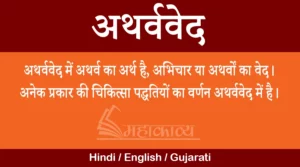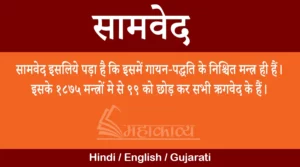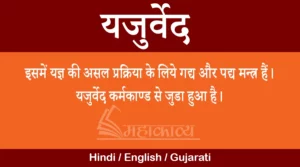Read Rig Veda in English
Definition of Rig veda (Rig veda in English) (Rik meaning position and knowledge) Rigveda is the first Veda which is verse. The first early source of Sanatan Dharma is Rigveda. Yajurveda, Samveda and Atharvaveda all three have been composed from Rigveda itself. The Rigveda is the verse Veda, the Yajurveda is the prose Veda and the Samaveda is the lyrical (song-music). Rigveda was composed in the north-western region from 1500 to 1000 BC. is considered of. Mantras and hymns of Rigveda have not been composed by any one sage. But as done by different sages in different times. Information about the tradition and history of Aryan politics is given in Rigveda.
Table of Contents
ToggleIntroduction to Rig veda:-
There are 10 mandalas, 1028 hymns in the entire Rigveda, and 11 thousand mantras in this hymn. The first division and the tenth mandal are bigger than all the other mandals. The number of hymns in this is also 191. The best part of Rigveda is from the second mandala to the seventh mandala. The 50 hymns at the beginning of the eighth mandala of the Rigveda have a sense of being similar to the first mandala.
Medicines are mentioned in the tenth mandala of Rigveda (Rig veda in English). 125 medicines have been described in it, it is mentioned to be found at 107 places. The description of Soma medicine is found at a special place in the Rigveda. An estimated 400 praises are found in the verses of Rigveda composed by many sages. This hymn describes the praise of deities like Suryadev, Indradev, Agnidev, Varundev, Vishwadev, Rudradev, Savita etc. This stuti is dedicated to the gods and goddesses.
Key facts about Rig veda:-
1 The definition of Rigveda is Rik meaning position and knowledge.
2. Rigveda is the first Veda of Sanatan Dharma, and the earliest source is Rigveda.
3. There are 10 mandalas in the gveda, in which there are 1028 hymns, and there are a total of 10,580 verses. Some of these circles are small, and some are big.
4. In many hymns of Agveda, there are mantras for the praise of the gods. There are other types of hymns in the gveda, but the hymns of praising the deities predominate.
5. In Rigveda, Indra is considered to be the most powerful deity to be accepted by all. There are 250 mantras in the Rigveda in praise of Indra.
6. There are 33 categories of deities mentioned in this Veda. The description of goddesses like Surya, Usha and Aditi is also found in Rigveda.
7. Both the first mandala and the last mandala of the Rigveda are equally large. The number of hymns in them is also 191.
8. Rigveda has two divisions by Ved Vyas Rishi, Ashtak order and Mandal order.
Department:-
The Vedas were earlier in a Samhita, but Vyasa Rishi studied them, for the sake of ease, the Vedas were divided into four parts. Due to this division he was named Ved Vyasa. Rigveda is divided into two sequences. (according to a popular opinion)
The division of Rig veda into two parts:-
1. octal sequence and
2. Chronology
1. Octave sequence :-
In the Ashtak sequence of Rigveda, eight Ashtaks and each Ashtak is divided into eight chapters separately. Each chapter is separated into sections. The total number of classes is 2006.
2. Chronology :-
In the Mandal order of Rigveda, the combined texts are divided into 10 mandalas. Mandal is divided into Anuvak, Anuvak Sukta and Sukta Mantra. There are 85 anuvakas, 1028 suktas in the ten mandals. And 11 Balkhilya hymns are also found. At present 10600 mantras are found in Rigveda.
The first mandala of Rigveda is believed to have been composed by many sages. But the second mandala is composed by sage Gritsamaya, third mandala is composed by sage Vishwamitra, fourth mandala is composed by Vamdev, fifth mandala is composed by Atririshi, sixth mandala is composed by sage Bharadwaj, seventh mandala is composed by sage Vashistha, eighth mandala is composed by sage Angira. The ninth and tenth mandalas are composed by more than one rishi. The dialogue of Pururava and Urvashi is found in 95 hymns of the tenth mandala of Rigveda.
Branches:-
21 branches are described in Rigveda. But according to the book Charanvyuh, there are five main branches. Which are as follows.
1. Shakal,
2. Vashkal,
3. oscillations,
4. Branching and
5. Mandukayan.
The number of mantras of the entire Rigveda is 10600. Later the tenth divisions were added, it is known as ‘Purushasukta’. The Shudras are first mentioned in the Purushasukta. After this Nasadiya Sukta, Marriage Sukta, Nadi Sukta, Devi Sukta etc. have been mentioned in this Mandal. Mention of Gayatri Mantra is also found in 7 mandalas of Rigveda, that mantra is popular mantra. The seventh mandala, composed by Rishi Vashistha, is dedicated to Varunadeva.
The sages wrote by counting the words and letters so that there should not be any kind of mixture in the Vedas. According to the index of Katyayana Prabhriti Rishis, the number of mantras is 10,580, the number of words is 153526 and according to the index of Shaunakrit there are 4,32,000 letters. Evidence is found in texts like Shatapatha Brahmana that the number of letters written by Prajapati was 12000 large. That is, 12000 times 36 i.e. 4,32,000 characters. The Rigveda which is available today in the form of Shakala Samhita contains only 10552 mantras. Read Rig Veda in hindi.
Read This Also
Shri Ramcharitmanas in English
Please wait while flipbook is loading. For more related info, FAQs and issues please refer to DearFlip WordPress Flipbook Plugin Help documentation.





 Download the Mahakavya App
Download the Mahakavya App